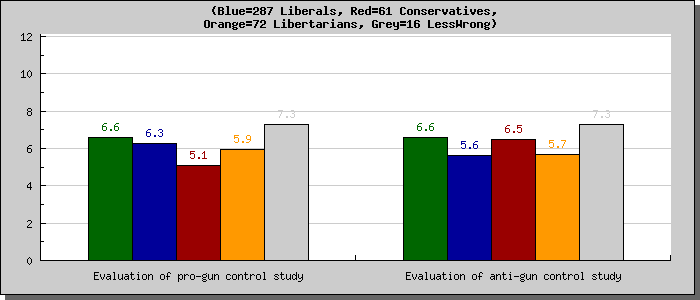YourMorals.Org |
||||
| Home |
Logout | Explore Your Morals | About Us | Links |
| Welcome gwern0@gmail.com - logout | ||||
|
The study you completed was an experimental investigation of
how people evaluate research evidence that either supports or opposes
their pre-existing beliefs. This study was based on work by Lord, Ross,
& Lepper (1979). You read about two studies, one showing evidence supportive of gun control laws preventing violent crime and one showing that gun control laws may actually lead to an increase in crime. Although these studies were technically fictitious and designed for the current project, they are based on actual research studies and arguments in the literature. For instance, although there is no actual study by Ellis and Powell, researchers have compared crime rates between states with and without strict gun laws. You were randomly assigned to one of two conditions: In one condition the pro-gun control study used a before-after design (measuring crime rates before and after a state enacted stricter gun laws) and the anti-gun control study used a between-states design (comparing crime rates between states with and without strict gun laws). In the second condition we reversed the study design for the pro- and anti-gun control studies. We also randomized whether you read about a pro- or anti-gun control study first. The idea behind the experiment is to test whether people's evaluations of scientific evidence depend on how the outcomes matched their prior attitudes. In other words, what matters to people is not the methodology, but whether the study confirms their prior attitude. In the past, studies have also shown that this effect tends to be stronger for people who hold strong attitudes on the issue in question. In the graph below, your score is shown in green. The scores of all liberals who have taken this study are shown in blue, and the scores of all conservatives are shown in red. The first graph shows your evaluation of the pro-gun control study and the second your evaluation of the anti-gun control study. Higher scores mean you rated that study as very well done and lower scores mean you thought the study was done poorly. You are a member of the group:LessWrong and those results are shown with the Grey bar.  To read more about the way people's pre-existing beliefs and values
can color their perceptions and judgments you can read this article from the Washington Post. There they refer to the effect as motivated skepticism but it is also called biased assimilation. |
Return to the "Explore" page.
|